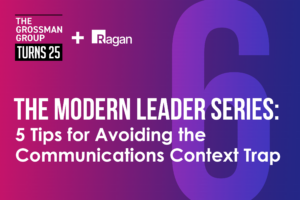The comms pro takeaways from the Golin CEO Impact Index
A look at the ties between top brass and communications.

In both good and bad times, people look to their leaders for guidance. In Golin’s 2025 CEO Impact Index, the data shows that the way top-level executives interact with employees and the media is shifting, and with that leadership comms needs to shift in turn. Internal communicators are often CEO whisperers, and the study’s findings had lots of relevant bits to apply to an organization of any size.
AI tech and the modern CEO’s leadership comms
AI technology has advanced a great deal over the past several years, especially for CEOs. The Index revealed that it was the leading topic for media coverage among Fortune 250 CEOs. For communicators, this means needing to take leadership talking points both internally and externally from concept into reality. For instance, communicators need to prepare their leaders to talk not just about the fact that AI will impact their companies, but how that’s going to happen. Will it mean a workforce reduction? Perhaps a change in company structure?
“Our top-ranked CEOs have pivoted from theoretical discussions to practical implementation and governance narratives,” Noel said. “Forward-thinking communications teams now showcase tangible AI results from infrastructure improvements and cost reductions to enhanced efficiency and customer experiences. They do this while simultaneously highlighting responsible governance frameworks.”
CEO visibility matters and has far-reaching effects
While the average CEO reached an employee engagement mark of just 44% approval, the Index revealed that the top 10 ranked CEOs in the study scored 20% percentage points higher in the employee engagement metric. The study also found that CEOs need to be a visible figure within their company and their industry. The Index reported that 7 of the top 10 got perfect scores in trade community engagement, a whopping 88 percentage points above the average CEO in the study.
But it’s what this visibility means that’s worth taking note of for internal comms pros.
“We’re witnessing a fundamental shift in CEO communications strategy,” said Megan Noel, global president of corporate affairs at Golin “The most successful teams have abandoned the traditional comms playbook in favor of a holistic approach to executive positioning.”
Noel said that CEOs who are great at employee engagement tended to rank highly in the index, with a positive correlation to employee approval. There’s also a cascade effect on employer reputation that comes right from the CEO and the leadership comms efforts around them.
“Employee engagement tells the story clearly in the study, as CEOs in our Index’s top 50 enjoy 76% employee approval,” Noel said. “That’s 10 points higher than the bottom 50. This translates directly to workplace advocacy with 74% of employees at top-performing companies willing to recommend their workplace compared to just 64% at bottom performers.”
Jonny Bentwood, global president of data and analytics at Golin said that CEO success often comes down to diversifying how a leader is perceived via comms.
“The CEO Impact Index analyzes 2.3 million data points revealing top executives don’t succeed through single-channel visibility,” he said. “Instead, they thrive by blending trade engagement, consumer presence, employee connection and thought leadership into a cohesive strategy.”
Noel also reiterated that the more a CEO is seen as their authentic self consistently (and positioned that way by comms), the stronger trust will be.
“CEO positioning sets the cultural tone through consistent visibility,” she said.
Leadership and the DEI discussion
Another hot-button topic for CEOs and the business world at large has been the wide-ranging rollback of DEI programs across the private sector amid the new presidential administration’s open hostility to diversity initiatives. The Index reported that DEI-related topics accounted for about 10% of CEO talking points for leaders in the report over the last year. But it’s also worth noting that sentiment around DEI fell to -13.9% in the second half of 2024, as opposed to just -3.9% in the first half of 2024. In this instance, sentiment refers to how the subject is approached with either a positive or negative tone and reception.
Noel said that this data shows that leaders and their communications team are responding to the current climate and shifting their talking points with employees away from wider social discussions and instead narrowing the focus of any DEI-related communication on the impacts on the company’s bottom line and successes. She added that, “In today’s landscape the most impactful CEOs don’t just run companies,” she said. They shape industries through strategic, multi-channel influence. This influence can directly correlate with improved employee engagement, retention rates and employee ambassadorship.”
Sean Devlin is an editor at Ragan Communications. In his spare time he enjoys Philly sports and hosting trivia.







